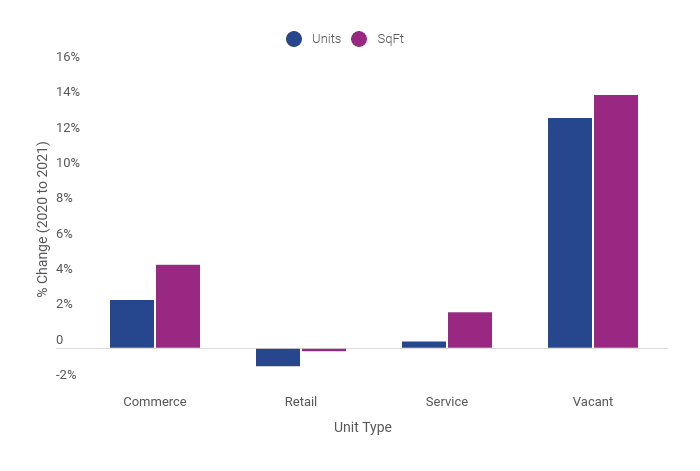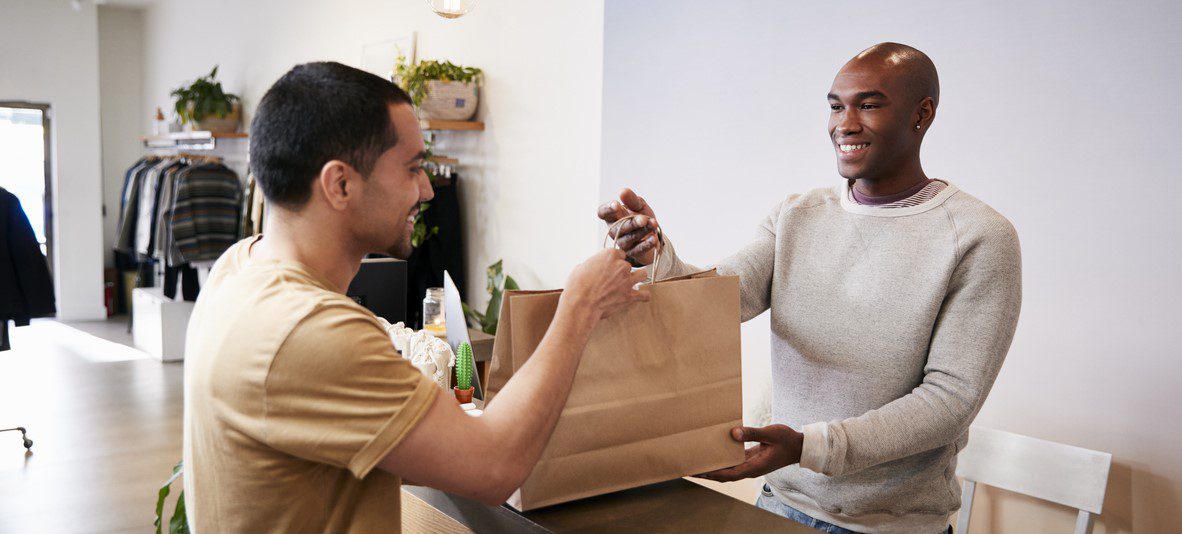The changing face of the high street
Using insights from Experian Goad, we can view the changes happening to each high street across the UK. Pulling these together enables us to see trends happening across the spectrum.
The UK high street changed markedly in 2020 with a 17% decline in the number of women’s clothing stores open compared to 2019. We also saw large declines in the number of financial services operators (including banks) and betting shops, while high streets are more likely to be filled with takeaways and beauty salons than in 2019.

With a 12% increase in the number of units and a 14% increase in vacant square footage, there is now over 120 million sq ft of commercial space lying empty, with the higher ratio of square footage against the number of units showing that larger format businesses failing have contributed to the increase in vacancy rates. This is likely to increase further as leases come to an end.
Too big to succeed?
Since the collapse of BHS, Toys R Us, and now Debenhams, there is the challenge on how to utilise these large and often inflexible spaces. The limited shop frontages compared to the total floorspace make them difficult to spilt or convert.
That’s not to say they cannot be filled, as some of the stores have been taken up by some of the larger format business that have seen expansion. These include the likes of B & M, The Range and Primark – but they could be the exception, rather than the rule. With the likely deluge of large format stores coming to market, trying to find the right tenants will be difficult.
What is the solution?
You don’t have to look far for the answer and this approach has been the mainstay of many large format stores: shop-in-shop. A recent example of this is Sainsburys’ acquisition of Argos. These are slowly being pulled into stores in a bid to increase sales per square foot.
Debenhams did have shop-in-shop already, so why would this concept work? The twist on this model would be ownership and accountability.
Instead of a company hiring the space and using their own employees to manage it, they invite small-to-medium sized business owners to run them. These businesses have typically had to settle for units in suburban areas that often cannot rely on footfall. They build their business reputation through high-quality service, word of mouth and local marketing.
Identify profitable locations with Experian GOAD
Find out moreHaving owners personally invested in higher footfall locations creates a shop-in-shop environment that has a drive and willingness for the business to succeed. There is accountability that simply isn’t seen in the same way when recruiting an employee versus an employer. The distinction between your job and your business is clear and the desire for the latter to succeed is far higher.
This mix of smaller individual shops; managed and run by their owners, will offer high and consistent quality of service across the store. Too often with large format stores, the quality of service you receive can be vastly different dependent on who serves you.
The unit could offer flexible spaces that could accommodate pop up shops. These can be used to gauge demand for new products or cater to more seasonal based products that don’t require space all year round. At a more extreme level, the units themselves could have different offering at different times of the day. The coffee shop becomes the cocktail bar and the casual dining area becomes the evening restaurant with different business owners responsible at these different times.
Too often in single shop formats the consumer is often left waiting, be it for a table or a haircut. Given the diverse nature on offer this would be a thing of the past, as the consumer can interact with many parts of the store. Technology can be used to aid in digital ticketing or ordering which is already growing through many retailers.

Success will come with a consistent high quality of service, accountability, and willingness to succeed as well as a diverse offering in one location. If organised correctly, this could offer the consumer the choice and service levels that were typically found in small local business but with the convenience and choice found in large department stores. Most importantly, the flexible nature of the unit offers a reason for the consumers to want to come back. There is always something new to see and do.
As we start to come out of lockdown with restrictions easing, we will start to see more and more people come back to shop on the high street, but it is yet to be seen to what level in store spending and footfall will return. As for which locations will thrive, yet again, this is to be seen. Pressure of high rents has held back some of the smaller traders’ ability to position themselves on high street locations, but a more fluid use of large format spaces could make this more affordable to smaller businesses.
For more insights on the changing retail landscape and updates on how the use of property and location space is affecting not only retailers but larger urban planning and transport solutions, contact us at businessuk@experian.com.
